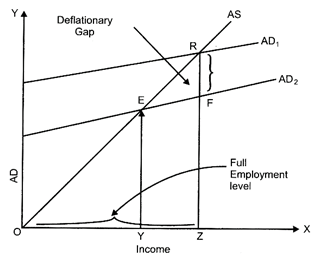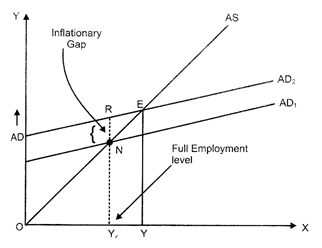Class 12 Economics Solved Paper (2013 Outside Delhi Set-II) | Additional Study Material for Commerce PDF Download
Ques 1: Give one reason for 'decrease' in supply of a commodity.
Ans: Increase in the price of inputs.
Ques 2: The price elasticity of supply of a commodity is 2.0. A firm supplies 200 units of it at a price of Rs. 8 per unit. At what price will it supply 250 units?
Ans: Given, Es= 2, P = Rs. 8, Q = 200 units, Q1 = 250 units∴ΔQ=Q1−Q=250−200=50 unitsLet the change in price, ΔP=xWe know that, or 2x=2 ⇒ x=1 or ΔP=1New price, P1=P+ΔP=8+1 = Rs. 9
or 2x=2 ⇒ x=1 or ΔP=1New price, P1=P+ΔP=8+1 = Rs. 9
Ques 3: When the price of a commodity falls by 20 per cent, its demand rises from 400 units to 500 units. Calculate its price elasticity of demand.
Ans:
Ed = 
= 25%
Ques 4: Distinguish between revenue expenditure and capital expenditure in government Budget. Give an example of each.
Ans: Capital expenditure: An expenditure which results in the creation of assets or reduction in liabilities is treated as Capital expenditure, such as expenditure incurred on construction of buildings, roads, bridges, etc.Revenue expenditure: An expenditure which does not result in creation of assets or reduction in liabilities, is called revenue expenditure such as payments of salaries, pensions, etc.
Ques 5: How does central bank control credit creation by commercial banks through open market operations? Explain.
Ans: Open market operations means the sale and purchase of all kinds of bills and securities by the ?central bank in the open market.? In narrow terms, this method signified sale and purchase of government securities by central bank in the open market. In short, according to this method central bank controls the volume of credit by increasing or decreasing the quantity of money in the economy through sale and purchase of securities in the money market. The functioning of this method is like this: When central bank of the country wants to increase the volume of credit, it starts purchasing securities from the market. These securities are generally bought at a higher price than the market price. As such, banks start selling them, as a result of which their cash reserves increase, i.e., their liquid assets increase. As a result of this, banks now can create more credit. On the contrary, when central bank wants to control the volume of credit, it starts selling securities in the market which are bought by the commercial banks. With the result, their cash reserves are reduced and this adversely affects their power of creating credit. In short, "for expanding the volume of credit central bank purchases securities and for reducing the volume of credit, it sells securities in the open market. In this way, according to this method, the volume of credit is controlled and regulated by controlling and regulating the cash reserves and credit creating power of commercial banks.
Ques 6: Distinguish between inflationary gap and deflationary gap. State two measures by which these can be corrected.
Ans: Deflationary gap: It prevails when aggregate demand is less than aggregate supply at the full employment level of output. In other words, deflationary gap represents the situation of unemployment attributable to the fact that at full employment level of output in the diagram RF is deflationary gap.
Inflationary gap ? This is the situation where economy operates at a level which is greater than full employment.
In other words, the gap between aggregate demand and aggregate supply is known as inflationary gap. In the diagram RN is inflationary gap. Volume of credit should be supervised and controlled for correcting the situation of deflationary and inflationary gap.
Two methods can be adopted for controlling these two gaps:
(i) Open market operations: If the central bank of the country will buy the securities from commercial banks, this will increase the capacity of credit paying of these banks. This way the deflationary situation can be corrected. If the central bank of the country sells the securities in the open market then the situation of inflationary gap will be controlled. Because of this the level of aggregate demand and their credit paying capacity will be reduced.
(ii) Bank Rate: Bank rate should be reduced. This will decline the rate of Interest. This is for controlling deflationary gap. In the case of inflationary gap bank should increase their rate, so that rate of interest will go up and the demand for credit will decline. This will affect aggregate demand.
Ques 7: In an economy C = 200 + 0.75 Y is the consumption function where C is consumption expenditure and Y is national income. Investment expenditure is 4,000. Calculate equilibrium level of income and consumption expenditure.
Ans:
Consumption function, C=200+0.75Y Investment, I = 4,000
Now Y=C+I or Y=200+075Y+4,000
Y0.75Y=4,200 or 0.25Y=4,200
Consumption expenditure, C= 200+0.75Y
=200+0.75(16,800)
=200+12,600=12,8000=12,8
|
4 videos|168 docs
|





















